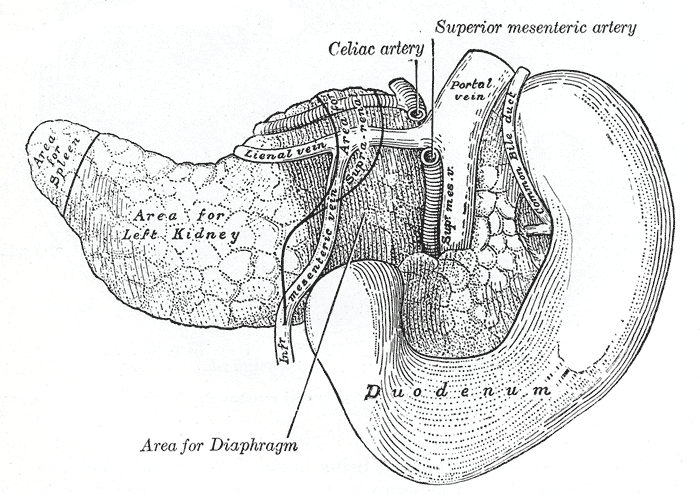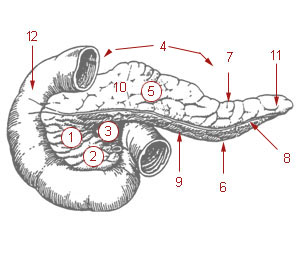Pancreatic injury on:
[Wikipedia]
[Google]
[Amazon]
A pancreatic injury is some form of

 Pancreatic injuries are classified according to the criteria of the
Pancreatic injuries are classified according to the criteria of the
trauma
Trauma most often refers to:
* Major trauma, in physical medicine, severe physical injury caused by an external source
* Psychological trauma, a type of damage to the psyche that occurs as a result of a severely distressing event
*Traumatic i ...
sustained by the pancreas
The pancreas is an organ of the digestive system and endocrine system of vertebrates. In humans, it is located in the abdomen behind the stomach and functions as a gland. The pancreas is a mixed or heterocrine gland, i.e. it has both an end ...
. The injury can be sustained through either blunt forces, such as a motor vehicle accident, or penetrative forces, such as that of a gunshot wound
A gunshot wound (GSW) is a penetrating injury caused by a projectile (e.g. a bullet) from a gun (typically firearm or air gun). Damages may include bleeding, bone fractures, organ damage, wound infection, loss of the ability to move part of th ...
. The pancreas is one of the least commonly injured organs in abdominal trauma.
Management

Diagnosis
The diagnosis of this form of injury can be challenging because of the pancreas' location inside the abdomen. The use ofultrasound
Ultrasound is sound waves with frequency, frequencies higher than the upper audible limit of human hearing range, hearing. Ultrasound is not different from "normal" (audible) sound in its physical properties, except that humans cannot hea ...
can reveal fluid around the site of injury. Computed tomography (CT) can also be utilized as a non-invasive diagnostic tool, but its reliability is low; one retrospective case review found that computed tomography had either failed to find injuries or had underestimated the severity of injury in more than half of 17 pancreatic injury patients. Serum amylase
An amylase () is an enzyme that catalyses the hydrolysis of starch (Latin ') into sugars. Amylase is present in the saliva of humans and some other mammals, where it begins the chemical process of digestion. Foods that contain large amounts of ...
has also been shown to be of limited diagnostic utility within the first three hours following injury.
Management of a pancreatic injury can be difficult because other abdominal
The abdomen (colloquially called the belly, tummy, midriff, tucky or stomach) is the part of the body between the thorax (chest) and pelvis, in humans and in other vertebrates. The abdomen is the front part of the abdominal segment of the torso. ...
organs
In biology, an organ is a collection of tissues joined in a structural unit to serve a common function. In the hierarchy of life, an organ lies between tissue and an organ system. Tissues are formed from same type cells to act together in a fu ...
, such as the liver
The liver is a major Organ (anatomy), organ only found in vertebrates which performs many essential biological functions such as detoxification of the organism, and the Protein biosynthesis, synthesis of proteins and biochemicals necessary for ...
, usually have sustained trauma as well. Several common symptoms manifest hours after the injury such as tachycardia
Tachycardia, also called tachyarrhythmia, is a heart rate that exceeds the normal resting rate. In general, a resting heart rate over 100 beats per minute is accepted as tachycardia in adults. Heart rates above the resting rate may be normal (su ...
, abdominal distension
Abdominal distension occurs when substances, such as air (gas) or fluid, accumulate in the abdomen causing its expansion. It is typically a symptom of an underlying disease or dysfunction in the body, rather than an illness in its own right. Pe ...
, and midepigastric tenderness. Indications for surgical intervention include: peritonitis
Peritonitis is inflammation of the localized or generalized peritoneum, the lining of the inner wall of the abdomen and cover of the abdominal organs. Symptoms may include severe pain, swelling of the abdomen, fever, or weight loss. One part or ...
based on physical examination
In a physical examination, medical examination, or clinical examination, a medical practitioner examines a patient for any possible medical signs or symptoms of a medical condition. It generally consists of a series of questions about the patien ...
; hypotension
Hypotension is low blood pressure. Blood pressure is the force of blood pushing against the walls of the arteries as the heart pumps out blood. Blood pressure is indicated by two numbers, the systolic blood pressure (the top number) and the dias ...
in combination with a positive focussed assessment with sonography (ultrasound) for trauma (FAST); and pancreatic duct
The pancreatic duct, or duct of Wirsung (also, the major pancreatic duct due to the existence of an accessory pancreatic duct), is a duct joining the pancreas to the common bile duct. This supplies it with pancreatic juice from the exocrine pancre ...
disruption based on the results of thin-cut computed tomography or endoscopic retrograde cholangiopancreatography
Endoscopic retrograde cholangiopancreatography (ERCP) is a technique that combines the use of endoscopy and fluoroscopy to diagnose and treat certain problems of the biliary or pancreatic ductal systems. It is primarily performed by highly skille ...
(ERCP). Commonly, a laparotomy
A laparotomy is a surgical procedure involving a surgical incision through the abdominal wall to gain access into the abdominal cavity. It is also known as a celiotomy.
Origins and history
The first successful laparotomy was performed without ane ...
is done in order to directly visualize the injury, and generally this approach is the most accurate diagnostic method.
Classification
 Pancreatic injuries are classified according to the criteria of the
Pancreatic injuries are classified according to the criteria of the American Association for the Surgery of Trauma
American(s) may refer to:
* American, something of, from, or related to the United States of America, commonly known as the "United States" or "America"
** Americans, citizens and nationals of the United States of America
** American ancestry, pe ...
(AAST). The grade of the trauma should be increased by one level for multiple injuries to the same organ. The description of the injury is that "based on most accurate assessment at autopsy, laparotomy, or radiological study." The pancreatic organ injury scale, as minimally modified, is:
Surgical treatment
When there is nopancreatic duct
The pancreatic duct, or duct of Wirsung (also, the major pancreatic duct due to the existence of an accessory pancreatic duct), is a duct joining the pancreas to the common bile duct. This supplies it with pancreatic juice from the exocrine pancre ...
injury, typically hemostasis
In biology, hemostasis or haemostasis is a process to prevent and stop bleeding, meaning to keep blood within a damaged blood vessel (the opposite of hemostasis is hemorrhage). It is the first stage of wound healing. This involves coagulation, whi ...
and surgical drainage
Drainage is the natural or artificial removal of a surface's water and sub-surface water from an area with excess of water. The internal drainage of most agricultural soils is good enough to prevent severe waterlogging (anaerobic conditio ...
are the main form of treatment. Surgical repair is undertaken when there is evidence or suspicion of ductal injury. The type of surgery depends on the degree of the injury and its proximity to the mesenteric blood vessels that serve the pancreas. When injuries are not close to the mesenteric vessels, a distal pancreatectomy may be done; this procedure preserves much of the pancreas and usually avoids loss of its endocrine
The endocrine system is a messenger system comprising feedback loops of the hormones released by internal glands of an organism directly into the circulatory system, regulating distant target organs. In vertebrates, the hypothalamus is the neu ...
and exocrine
Exocrine glands are glands that secrete substances on to an epithelial surface by way of a duct. Examples of exocrine glands include sweat, salivary, mammary, ceruminous, lacrimal, sebaceous, prostate and mucous. Exocrine glands are one of two ...
functions. In severe cases of pancreaticoduodenal injury, a pancreaticoduodenectomy
A pancreaticoduodenectomy, also known as a Whipple procedure, is a major surgical operation most often performed to remove cancerous tumours from the head of the pancreas. It is also used for the treatment of pancreatic or duodenal trauma, or chro ...
can be used. Common complications after surgery include pancreatitis
Pancreatitis is a condition characterized by inflammation of the pancreas. The pancreas is a large organ behind the stomach that produces digestive enzymes and a number of hormones. There are two main types: acute pancreatitis, and chronic pancr ...
, pancreatic fistula
A pancreatic fistula is an abnormal communication between the pancreas and other organs due to leakage of pancreatic secretions from damaged pancreatic ducts. An ''external'' pancreatic fistula is one that communicates with the skin, and is also kn ...
, abscess
An abscess is a collection of pus that has built up within the tissue of the body. Signs and symptoms of abscesses include redness, pain, warmth, and swelling. The swelling may feel fluid-filled when pressed. The area of redness often extends b ...
, and pseudocyst
Pseudocysts are like cysts, but lack epithelial or endothelial cells. Initial management consists of general supportive care. Symptoms and complications caused by pseudocysts require surgery. Computed tomography (CT) scans are used for initial ima ...
formation. Initial management of hemorrhage
Bleeding, hemorrhage, haemorrhage or blood loss, is blood escaping from the circulatory system from damaged blood vessels. Bleeding can occur internally, or externally either through a natural opening such as the mouth, nose, ear, urethra, vag ...
includes controlling it by packing the wound.
History
The first recorded case of pancreatic injury was published in ''The Lancet
''The Lancet'' is a weekly peer-reviewed general medical journal and one of the oldest of its kind. It is also the world's highest-impact academic journal. It was founded in England in 1823.
The journal publishes original research articles, ...
'' in 1827. At the time, death as a result of injury was deemed to be "universal". The first successful surgery to repair a transected pancreas was performed in 1904 by Garré, who reported the case the following year.
References
External links
External links
{{Nonmusculoskeletal injuries of abdomen and pelvis Injuries of abdomen, lower back, lumbar spine and pelvis